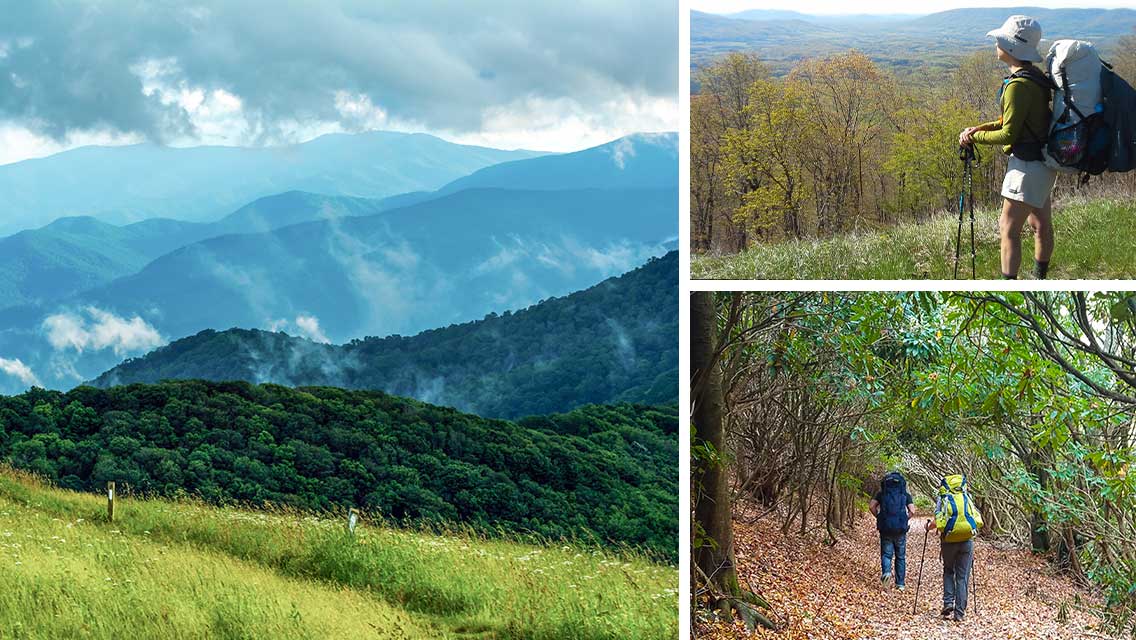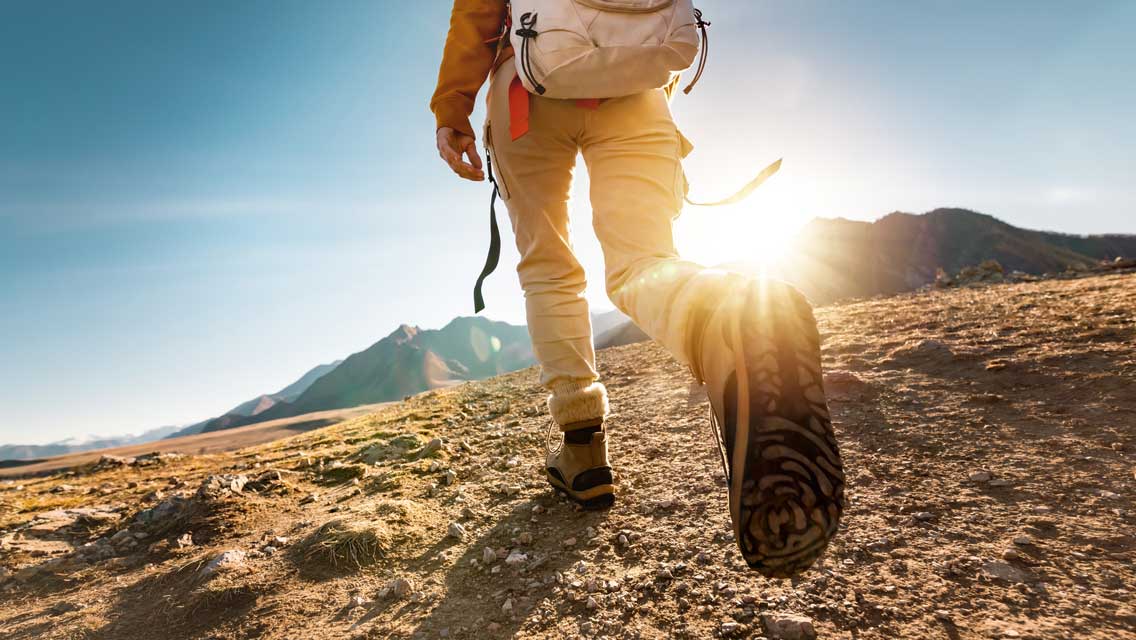The world looks marvelous from atop Max Patch — a 4,629-foot mountain “bald” located in the North Carolina section of the Appalachian Trail (AT). I gape at expansive skies and stunning panoramas of surrounding summits, including Tennessee’s famous Great Smoky Mountains. Ominous clouds gathering in the distance don’t faze my fellow travelers, who are pitching their tents and throwing Frisbees for four-legged friends.
The dome is a popular stopover for thru-hikers (backpackers who walk the entire 2,180 miles of the AT in 12 months or less), a place to pinch off epic views, remove their boots, and soak up the sun like the glorious wildflowers surrounding them. It’s also beloved by sectional hikers (those who cover the entire trail in sections during their lifetime), as well as day hikers and locals who climb the peak simply to picnic on a sunny afternoon.
My trek to this picturesque grassy mountain patch started earlier in the day some five miles north at Lemon Gap, N.C. I traversed a route that crossed streams, snaked amid shady forests, and meandered through a dense tunnel of rhododendron. I tramped over giant tree roots pushing up from the ground and survived several unrelenting climbs.
My shoulders ache, my feet hurt, but I feel fierce — and free.
Winds of Change
I nod off that night thinking about the idyllic scene at Max Patch. But I’m awakened by winds roaring like a train through the trees. The inland-pushing remnants of Hurricane Nate have arrived with a vengeance.
I unzip my mummy sack and feel around — like Velma from Scooby-Doo — for my glasses and head lamp.
Rain begins dappling my tent fly. Harder and harder it falls. I peek outside and see drops swirling from all directions, battering the towering grove of trees above. Thinner trunks rock. Limbs creak and shake. I remind myself that trees are designed to bend. To withstand. To endure. If they can stand strong in the line of fire, so can I. But will my tent?
I inhale deeply, listening to nature’s ferocity. I’m thankful I took the extra precaution (thanks to our guide’s knot-tying knowledge) of using guy lines to tether my triangular room to a couple of these storm-surviving trees.
While it’s not my first backpacking adventure, I elected to take a guided trip on the AT because I plan to solo hike another section and wanted the opportunity to ask questions of a seasoned trekker. To gain insight into what I knew — and what I didn’t — about taking care of myself in the woods, I enlisted the help of the experienced outdoorsy types of Blue Ridge Hiking Company).
Founded in 2008 by record-setting AT thru-hiker Jennifer Pharr Davis to share her love and knowledge of hiking in the southern Appalachian Mountains, the company employs savvy guides who lead about 175 people on hikes each season. (To read more about Davis, visit “Jennifer Pharr Davis: Trailblazer“.)
A guided hike is a great way to test equipment, which can cost anywhere from hundreds to thousands of dollars, depending on the brands and whether the gear is new or used. Blue Ridge Hiking Company provides tents, backpacks, sleeping bags, and pads at no extra charge. See their site for current pricing and package offerings. The company offers women- and family-only outings, trips geared to beginners and advanced hikers, and custom itineraries.
“It was great going on an overnight hike without worrying about purchasing all of the gear and food or getting lost,” says Diane “Rock Diver” Alderson, 46, of Mebane, N.C. “I could really focus on the experience.”
“I learned that it’s important to take only what you absolutely need,” she cautions. “The ounces really add up!” (For 10 backpacking essentials, visit “Backpacking 101“.)
More Than Backpacking
Any good guide will teach leave-no-trace principles, safety basics such as properly securing food, and how to read topographical as well as trail maps. But many also have specific areas of expertise that make every outing a unique experience for newbie and longtime backpackers alike.
Our guide, clinical herbalist Lori “Sky Wolf” Wilkin, shared in-depth -information on the plants lining the trail, including tips for determining edibles. It was her story about the natural history of the American chestnut tree, though, that left the biggest impression on me. The loss of this community of giants has had an impact — both economically and ecologically — on the world. Their story also offers lessons crucial to understanding how to respond to species loss at a time of rapid climate change.
Once numbering nearly 4 billion in North America, the American chestnut was prized by the lumber industry for its rot resistance, as well as by birds and animals for its nuts. In the early 1900s, the population was decimated by an Asian fungus — cryphonectria parasitica, or chestnut blight. By some estimates, 3.5 billion American chestnuts were lost, one of the world’s great ecological disasters.
Through community science programs and biotechnology (including regional and backcross breeding of American and Chinese chestnuts), the American Chestnut Foundation and other organizations are now working to restore the species and the greater Appalachian ecosystem.
Chestnuts are vital to the region because their fast growth restores degraded soils and biodiversity. They also produce reliable, abundant food for wildlife and provide prime timber.
Coming Together
The AT itself, which runs through multiple states and requires the efforts of federal and local agencies to maintain, is a reminder that when groups of people work together, they can both create and protect something beautiful.
That’s one reason people from around the globe walk this storied pathway. But they’re also called for other reasons: to challenge themselves physically and mentally, to recover from trauma or loss, or to plan their next steps in life.
“Most people I met on the trail were retirees, on sabbaticals from their careers, college-age students, or former military personnel processing what they experienced while on active duty,” explains Mary Ann Hyde of St. Paul, Minn.
The 60-year-old retired nurse completed her solo thru-hike of the trail in 2016. She’d never backpacked before joining the 2,000-mile club — those who have hiked the entire trail.
Like Hyde, lots of people hike the AT alone, but many explore it with a friend or in groups. I met a gaggle of overnight hikers, consisting largely of strangers who met via a website, in one of the trail’s iconic shelters.
Whether they went solo or with buddies, anyone who has hiked the AT for a few days is likely to fondly recall the connections made with others. “I loved gathering in the shelters at the end of the day to meet people and hear their stories,” Hyde says. “We really have so much more in common than differences.”
People of all ages and skill levels hike the AT. In 2017, Dale “Graybeard” Sanders, at 82, became the oldest person to thru-hike the trail. In the same year, 18-month-old Elie Quirin became the youngest person to hike it — on the backs of her parents, Bekah and Derrick.
“I’ve taken kids as young as 3 and as old as 74 on overnight hikes,” says guide Sarah Matzke, 39, of Asheville, N.C. “Fitness levels often vary considerably, and experience in the backcountry varies between extreme beginner to a backpacking trip taken some time ago.”
For me, exploring the AT was the fulfillment of a dream. It was an opportunity to explore the Eastern American woods walked by pre-industrial ancestors. It was a moment to reconnect with nature, showing me my place in the world in a way that driving and biking can’t. It’s a defiant act to proceed slowly in a world urging us to move at warp speed.
Happy Trails
The Appalachian Trail is the most popular scenic trail in the United States. These are a few less-traveled footpaths.
American Discovery Trail (ADT)
For: Anyone wanting to explore the United States from sea to shining sea.
Length: Around 6,800 miles from Delaware to California, the ADT traverses rural America and major cities, including Washington, D.C., and San Francisco, and traverses 14 national parks.
Completion time: Typically 18 to 24 months.
Continental Divide Trail
For: Those looking for a Rocky Mountain high.
Length: Approximately 3,100 miles following the Continental Divide from the border of Canada through New Mexico. The highest and most challenging of the National Scenic Trails, it passes through glacial valleys and crosses mountains.
Completion time: Typically six to eight months.
North Country Trail
For: Hikers who enjoy traveling where the winds hit heavy on the borderline.
Length: Stretching about 4,600 miles from New York to North Dakota, it cuts through diverse landscapes, including the Adirondack Mountains, Great Lakes shores, and Dakota prairies.
Completion time: Typically eight to 10 months.




This Post Has 0 Comments